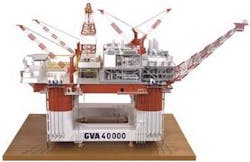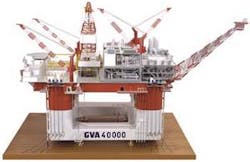Sweden: GVA Consultants progressing toward EPC services for semisubmersibles
Victor Schmidt
Exploration Editor
GVA Consultants, now a part of the Halli-burton group, aims to extend its capa-bility to the offshore industry as part of the Halliburton KBR Offshore Opera-tions division (KBR). The company will continue to operate independently but now can offer topside design through KBR, delivering engineering, procurement, and construction (EPC) services.
Semis vs Spars
Both GVA Consultants (GVA-C) and KBR share the philosophy that the semisubmersible is a preferred design over Spars for deepwater developments. The basis for their reasoning is the capital expenditure savings of $50-100 million that can be achieved with semis for comparable working environments. This assertion rests on three main points:
- Total hull and subsea costs are lower for a semi than for a comparable Spar
- Topsides can be installed and commissioned at quayside in the shipyard, saving an expensive offshore installation and hookup
- Mooring systems cost less for a semi due to smaller displacement.
The operating expenditures for the two systems are similar, as are the drilling and intervention capability of the two designs.
Another advantage of the semi design is the safety factor. The semi does not have live wellheads in the center of the platform, which provides for a much safer operating environment. The rig can be centered over the wells for intervention work or new well drilling through a marine riser, but it can also be moved away from the template in the event of a blowout or during normal production operations. Last, the semi is reusable and can be easily moved to new locations while the Spar is a less flexible system.
Thunder Horse/Atlantis
GVA-C's most recent success is the GVA 40000 design currently under construction for BP's Thunder Horse project. This Gulf of Mexico drilling and production semisubmersible project was a front-end engineering and design (FEED) project for BP, completed two weeks ahead of schedule this past March.
The next phase will involve assistance to the project management at the shipyard, Daewoo Shipbuilding in Korea, which won the contract for construction of the hull. That work is under way with BP as project manager, but with GVA-C as integrated advisors. Detailed design work was completed in June. Hull fabrication is now also under way, and toward the end of 2003 the hull with marine and drilling systems, as well as accommodation facilities, will be completed.
The hull will then be moved to the Kiewit yard in Corpus Christi, Texas, where the topside modules are to be installed. After the load-out from Daewoo, the heaviest dry tow in the industry's history will take place. Dockwise, now upgrading the Black Marlim vessel to handle the transport, will perform this dry tow. An upgrade to the vessel was required and included hull widening, structural reinforcement, and performance enhancement.
The Thunder Horse semi will be moored in 6,000 ft water depth, and first oil from the field is anticipated in 2005. Its processing system is designed to handle 250,000 b/d of crude oil, 200 MMcf/d of natural gas, and 300,000 b/d of water injection.
The semi will have a 16-point, semi-taut chain-wire mooring system. Its dual-activity derrick is designed for efficient drilling performance with a main hook load of 1,000 tons and an auxiliary hook load of 500 tons.
The advantage of this large semi design is the combination of production, drilling, and quarters in one unit. The design avoids dry trees and the tensioned risers necessary to connect them to the seabed.
GVA-C is also performing a FEED project for BP's Atlantis field in the Gulf of Mexico. GVA-C is designing the GVA 27000 semisubmersible for the field. The company will design the hull, the marine systems, and utility systems for the project while Mustang Engineering is designing the process modules. KBR is supporting GVA-C with power, hydrodynamics, and air systems design.
Iranian project
The Khazar field in Iran's sector of the Caspian Sea is located in a moderate environment. The enclosed Caspian Sea requires that any drilling unit to be fabricated must be done locally on its shores. The GVA 4000M design was chosen for the field and is now being built by Sadra at its Neka yard on the southeastern Caspian coast. The drilling unit will have a 5,000-ton deck load and is designed to operate in 3,300 ft water depths, the maximum depth in the Caspian Sea.
Construction of the drilling unit began in January 2002 and is expected to take 32 months. It should be completed in 2004. In addition to design and project monitoring, GVA-C will also provide significant construction assistance to the yard and will train Iranians in advanced construction techniques.
Elsewhere, Aker-Kværner is guiding Statoil's Kristin field gas project off Norway since it won the engineering, procurement, construction, and hookup contract. The GVA 50 design was chosen for the gas production unit field and is presently being adjusted to satisfy the field's specific needs.
Smaller semis
GVA-C is specialized in naval architecture and provides project management, naval architecture and structural design, marine drilling system design, as well as cost estimation, procurement, and construction services. Its core of 60 professionals is augmented by 120 consultants, who work on different aspects of the projects.
The company sees a growing need for smaller production units for smaller field developments and a further need to address the priorities of independent companies. For this purpose GVA-C is currently developing a new range of production semis that will be presented later this fall.
The new units will rely on their experience from small semi design, such as the MSV Regalia, a multi-service semi of the smaller GVA 3000 series, which, among other things, was used to recover the Russian nuclear submarine Kursk. Another example of its small semi capability is the Safe Lancia, a GVA 2000 accommodation unit housing 600 men. The same design can be modified for the production needs of smaller fields.
The company has also developed its production module system concept for low-cost field development using an existing semi and a new-build add-on production module.
To date the company has produced 15 semisubmersibles for accommodation, diving, and drilling and production operations. Displacement sizes of the vessels range from 13,000 tons up to 130,000 tons and the operating scenarios required varied worldwide from shallow North Sea waters to deepwater areas in the Gulf of Mexico and off Brazil.
Finally, floating dry docks are probably not the largest selling product on the market, but whenever a project comes up GVA-C is ready. Most recently Saudi Aramco has ordered a floating dry dock to be designed by GVA-C. The 4,500-ton lifting capacity unit will be built by Dubai Drydocks for use in the Persian Gulf. This is the third contract for GVA-C out of three projects offered during the last 10 years.
For more information contact: Robert Ludwigson, GVA Consultants. Tel: +46 31 10 67 00, fax: +46 31 10 67 10, email: [email protected].

